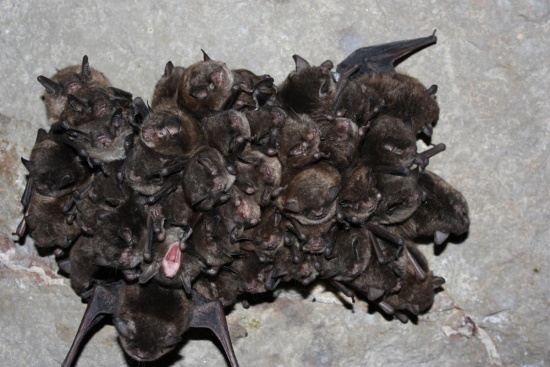Yet again, I peer out the window in the early morning to see if my little hummingbird friends have arrived for breakfast and, yet again, no hummingbirds and all the nectar is gone. I think, “Hummingbirds aren’t nocturnal, are they? There was plenty left when we went to bed.” I decide to go on our NextDoor website and see if any local people have a clue. We’ve only been here 4 months and I’m the one who hasn’t a clue!

No, this lesser long-nosed bat doesn’t have yellow fur. It’s covered in pollen after a busy night of drinking nectar.
Almost immediately someone responds and says, “Oh, yes, this is BAT season! Every night the nectar-feeding bats fly in from wherever they roosting and drain the hummingbird feeders.” Some people advise to cover the feeder or bring it in at night but others like me are happy to let the bats finish off whatever nectar the hummers haven’t gotten in the daytime. In the morning we bring in the feeder, wash it off, fill it and replace it for the day. No waste here! These are the Lesser Long Nose bats, the great pollinators of the desert southwest.
For some people bats conjure up scary images of rabies and vampires and it’s true they can carry rabies but I’m glad they’re here. Bats are voracious eaters of insects including mosquitoes and it’s far more likely that I could get bitten by a West Nile carrying mosquito than get bitten by a rabid bat.
We put out a night vision video camera and look what we got! Thrilling!

Lesser Long Nose bats are very common in the desert southwest. They drink nectar and are great pollinators.
Here’s what the U.S Department of the Interior says about “our” night visitors: Small but mighty, the lesser long-nosed bat is the unsung hero in maintaining fragile desert ecosystems. Measuring about 3 inches long and with a brush-tipped tongue that is as long its body, this species is the perfect pollinator. Every year, it migrates from its winter home in Mexico, following the “nectar trail” of blooming cacti and agave flowers to southern Arizona and New Mexico. Along the way as it drinks the sweet nectar, the lesser long-nosed bat picks up pollen, spreading it from flower to flower. Both the saguaro cactus and agave depend on it for pollination. When it was listed as an endangered species in 1988, there were fewer than 1,000 of these nectar-feeding bats. Today, there are an estimated 200,000 bats at 75 roosts in the Southwest and Mexico. Thanks to a three-decade-long conservation partnership, the bat was saved from extinction and delisted in 2018 — making the lesser long-nosed bat a conservation success story.
Here are some other kinds of bats that live in the United States.






Do your part to help bats by building a bat house. These structures are a win for both bats and humans. They can hold up to 100 bats, providing them with much need roosts while the bats keep the pests at bay around your house.
Find e-Handbook bat house plans in the MOTHER EARTH NEWS store.
All MOTHER EARTH NEWS community bloggers have agreed to follow our Blogging Guidelines, and they are responsible for the accuracy of their posts.










